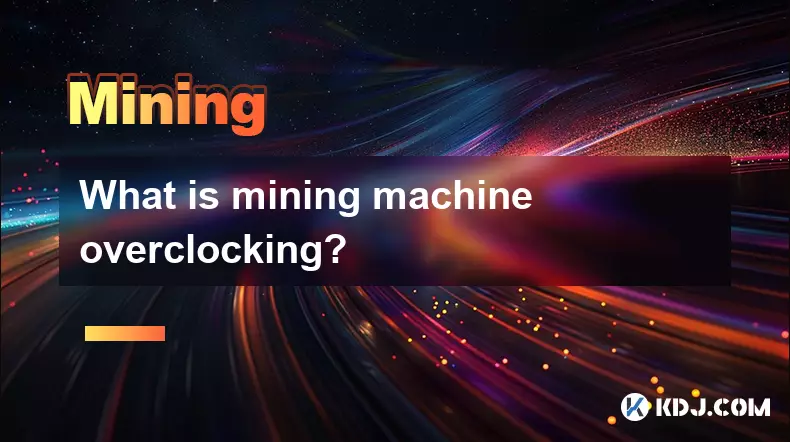-
 bitcoin
bitcoin $109547.008142 USD
0.04% -
 ethereum
ethereum $4011.838726 USD
-0.05% -
 tether
tether $1.000402 USD
-0.01% -
 xrp
xrp $2.798606 USD
0.88% -
 bnb
bnb $970.877944 USD
1.39% -
 solana
solana $202.237275 USD
-0.95% -
 usd-coin
usd-coin $0.999673 USD
0.00% -
 dogecoin
dogecoin $0.229294 USD
-1.15% -
 tron
tron $0.336370 USD
-0.45% -
 cardano
cardano $0.777260 USD
-1.66% -
 hyperliquid
hyperliquid $45.503019 USD
1.73% -
 ethena-usde
ethena-usde $1.000362 USD
0.01% -
 chainlink
chainlink $20.785303 USD
-1.10% -
 avalanche
avalanche $28.755822 USD
-0.11% -
 stellar
stellar $0.358303 USD
-0.48%
What is mining machine overclocking?
Overclocking mining machines boosts hash rates for higher profits but increases heat, power use, and hardware risks, requiring careful tuning and cooling to maintain stability and longevity.
Sep 21, 2025 at 07:19 pm

Understanding Mining Machine Overclocking
1. Mining machine overclocking refers to the process of increasing the operating frequency of a cryptocurrency mining device beyond its factory-set specifications. This adjustment aims to boost the hash rate, allowing the machine to solve cryptographic puzzles faster and potentially earn more rewards in proof-of-work networks like Bitcoin.
2. Most mining hardware, particularly ASICs (Application-Specific Integrated Circuits) and high-performance GPUs, are designed with conservative clock speeds to ensure stability and longevity. However, miners often push these limits to extract maximum performance from their equipment.
3. Overclocking is typically achieved through firmware modifications or configuration tools provided by third-party software developers. These tools allow users to adjust core clock, memory clock, voltage settings, and power limits.
4. The primary motivation behind overclocking is profitability. A higher hash rate can lead to increased block discovery rates, especially in competitive mining pools where contribution determines reward distribution.
5. While the performance gains can be significant, overclocking introduces additional risks such as thermal stress, hardware instability, and shortened device lifespan. Proper cooling and monitoring are essential to maintain operational integrity.
Risks Associated with Overclocking Mining Equipment
1. Excessive heat generation is one of the most immediate consequences of overclocking. Elevated temperatures can cause thermal throttling, reducing efficiency, or in extreme cases, permanent damage to semiconductor components.
2. Power consumption increases when a mining rig operates at higher frequencies. This not only raises electricity costs but may also exceed the capacity of existing power supplies, leading to system failures or circuit overloads.
3. Stability issues often arise when pushing hardware beyond its intended limits. Crashes, rejected shares, and inconsistent hash output reduce overall mining efficiency and can result in financial losses despite higher theoretical performance.
4. Manufacturer warranties are typically voided when overclocking is detected. Since most ASIC producers lock down firmware, any unauthorized modification invalidates support and replacement rights.
5. Long-term reliability diminishes under sustained overclocked conditions. Components degrade faster due to elevated voltage and heat, increasing the likelihood of premature failure and unplanned downtime.
Performance Gains and Practical Considerations
1. Successful overclocking can yield hash rate improvements ranging from 10% to over 30%, depending on the model and baseline configuration. For large-scale mining farms, even a modest percentage increase across hundreds of units can translate into meaningful revenue gains.
2. Not all machines respond equally to overclocking. Some ASIC models have tightly optimized firmware that leaves little room for enhancement, while others—especially older generations—may offer more flexibility.
3. Miners must balance performance against energy efficiency. An overclocked machine consuming significantly more power per terahash may become unprofitable if electricity rates are high or coin prices fluctuate downward.
4. Real-time monitoring tools are critical for tracking temperature, fan speed, power draw, and accepted/rejected share ratios. These metrics help operators fine-tune settings to maintain optimal operation without crossing safety thresholds.
5. Community-driven forums and developer groups often share stable overclocking profiles tailored to specific hardware. Leveraging tested configurations reduces trial-and-error risk and accelerates deployment.
Common Questions About Mining Overclocking
What tools are commonly used for overclocking ASIC miners?Popular tools include Vnish, Braiins OS, and Awesome Miner, which provide user-friendly interfaces for adjusting clock speeds, voltages, and fan controls. These platforms often include safety features to prevent catastrophic failures during tuning.
Can GPU mining rigs be overclocked more safely than ASICs?GPUs generally offer greater flexibility and resilience to overclocking compared to ASICs, which are built for singular algorithms and lack general-purpose design. However, both require careful thermal management and power regulation to avoid damage.
Does overclocking affect pool mining performance?Yes. If an overclocked miner produces unstable output with frequent rejected shares, the mining pool may penalize or limit its contribution. Consistent and valid submissions are crucial for maintaining reputation and earning potential within pooled operations.
Is it possible to revert overclocking changes if problems occur?Most firmware solutions allow rollback to default settings. Flashing original firmware or restoring backups typically returns the device to factory condition, assuming no physical damage has occurred during the overclocking process.
Disclaimer:info@kdj.com
The information provided is not trading advice. kdj.com does not assume any responsibility for any investments made based on the information provided in this article. Cryptocurrencies are highly volatile and it is highly recommended that you invest with caution after thorough research!
If you believe that the content used on this website infringes your copyright, please contact us immediately (info@kdj.com) and we will delete it promptly.
- Crypto Whales, PEPE, and Meme Coins: What's the Hype?
- 2025-09-28 18:25:15
- Polkadot pUSD: NYC's Take on Decentralized Stability
- 2025-09-28 18:25:15
- SWIFT, Ethereum, and Linea: Revolutionizing Global Banking?
- 2025-09-28 18:30:01
- Crypto, Altcoin, Buy Now: Navigating the 2025 Landscape
- 2025-09-28 18:30:01
- MoonBull, Crypto, and Shiba Inu: What's the Buzz in the Crypto Space?
- 2025-09-28 18:30:01
- Qurax Exchange Spot Trading and Token Listings: A New Era?
- 2025-09-28 18:30:12
Related knowledge

The difference between staking and mining
Sep 24,2025 at 05:18am
Understanding Staking in the Cryptocurrency Ecosystem1. Staking involves holding funds in a cryptocurrency wallet to support the operations of a block...

How to participate in testnet mining?
Sep 22,2025 at 09:18am
Understanding Testnet Mining in the Crypto Ecosystem1. Testnet mining is a method used by blockchain developers to simulate real-world conditions on a...

How to dispose of abandoned mining machines?
Sep 19,2025 at 08:19pm
Assessing the Condition of Abandoned Mining Rigs1. Begin by inspecting each mining machine for visible damage, corrosion, or missing components. Machi...

How to identify high-quality mining pools?
Sep 21,2025 at 03:19pm
Reputation and Track Record1. A mining pool’s reputation is built over time through consistent performance and transparency. Pools that have operated ...

Advantages of decentralized mining pools
Sep 20,2025 at 04:36pm
Enhanced Security and Resistance to Censorship1. Decentralized mining pools operate on blockchain-based smart contracts, eliminating the need for a ce...

What is mining machine overclocking?
Sep 21,2025 at 07:19pm
Understanding Mining Machine Overclocking1. Mining machine overclocking refers to the process of increasing the operating frequency of a cryptocurrenc...

The difference between staking and mining
Sep 24,2025 at 05:18am
Understanding Staking in the Cryptocurrency Ecosystem1. Staking involves holding funds in a cryptocurrency wallet to support the operations of a block...

How to participate in testnet mining?
Sep 22,2025 at 09:18am
Understanding Testnet Mining in the Crypto Ecosystem1. Testnet mining is a method used by blockchain developers to simulate real-world conditions on a...

How to dispose of abandoned mining machines?
Sep 19,2025 at 08:19pm
Assessing the Condition of Abandoned Mining Rigs1. Begin by inspecting each mining machine for visible damage, corrosion, or missing components. Machi...

How to identify high-quality mining pools?
Sep 21,2025 at 03:19pm
Reputation and Track Record1. A mining pool’s reputation is built over time through consistent performance and transparency. Pools that have operated ...

Advantages of decentralized mining pools
Sep 20,2025 at 04:36pm
Enhanced Security and Resistance to Censorship1. Decentralized mining pools operate on blockchain-based smart contracts, eliminating the need for a ce...

What is mining machine overclocking?
Sep 21,2025 at 07:19pm
Understanding Mining Machine Overclocking1. Mining machine overclocking refers to the process of increasing the operating frequency of a cryptocurrenc...
See all articles









































































